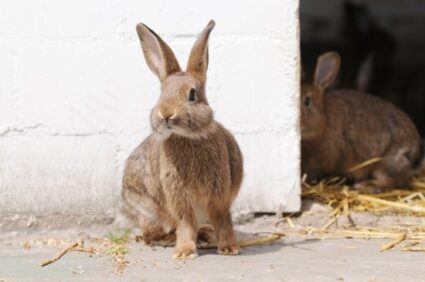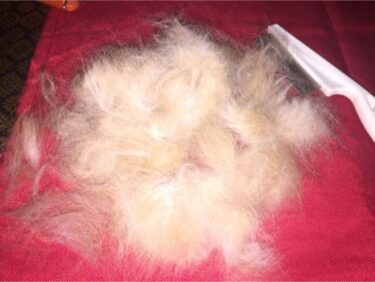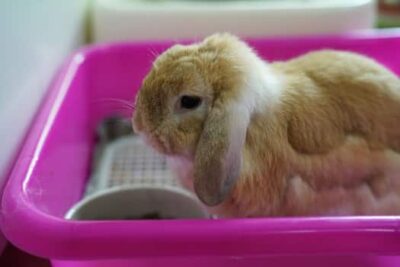Shedding fur is something that we have to accept as pet owners. Unless you live with a hypoallergenic rabbit, you’ll always experience piles of dander. Some people are surprised by how much fur a rabbit sheds. This could be natural, or it may be a warning sign of ill health.
If shedding happens during the spring, it’s nothing to worry about. Rabbits shed their thick winter coat as it’s no longer needed for warmth. If your rabbit molts out of season, though, something is wrong. Rabbits shed their fur when stressed, so ensure that your pet is comfortable and content.
Rabbits molt four times annually, though no other occurrence is as drastic as their springtime shedding. There is also a pattern to an organic molting, which you’ll need to recognize. This guide will help you understand if your pet is molting naturally, or experiencing a health concern.
Do Rabbits Molt Naturally?
Rabbits do shed their fur and molt throughout their life cycle. There is a limit to how much fur a rabbit should lose at a time, though.
If you notice patchy hair loss in your rabbit, ensure that it’s happening organically. Rabbits can be prone to pulling their fur out in clumps. This is a warning sign of stress, boredom or ill health.
A rabbit constantly molting is also not a good sign. They should only shed their fur roughly every three months. Any more than this merits further investigation.
How Can I Tell if My Rabbit is Molting Naturally?
When your rabbit starts to molt, it will follow a distinct arrangement. They will initially lose fur from their head, continuing down the neck and back. It will culminate around the stomach and tail.
This whole process will take somewhere between two and six weeks. Every rabbit is different, and experiences a varying timespan for their molt.
Your rabbit may lose their fur in clumps, leaving bald patches on their body. Usually, it’s a consistent process. If you spot a bald patch, ensure it’s due to molting and not self-mutilation or illness.
Perhaps the main sign of natural molting is the time of year that it occurs. Molting is a seasonal activity in bunnies. If they lose their fur all year around, there will be a reason.
What are Standard Rabbit Shedding Patterns?
A rabbit goes through several molting patterns throughout their life. As a bunny owner, you’ll need to learn what is natural and what merits concern.
A rabbit will undergo their first molt at around 4 or 5 months of age. At this stage, they will shed their baby fur. An intermediate coat will replace this.
This intermediate coat will last around three months. Once this period concludes, your rabbit’s adult fur will grow. From here, they will molt again roughly every three months.

The reason for this is simple. Rabbits are traditionally outdoor animals, and they molt with the seasons. Bunnies lose their thick winter fur during the spring, replacing it with a lighter coat. This keeps them cool through summer.
Naturally, as the fall starts to close in, rabbits need thicker fur. They’ll molt again, developing a protective layer of hair to keep them warm.
Some rabbits even change color during their winter molt. This is perfectly natural, and nothing to worry about. Rabbit fur lightens in the shade during the winter, helping them camouflage themselves in snowy climes.
How Much Shedding is Normal in a Rabbit?
This depends on upon the time of year. A rabbit will shed a significant amount more fur in spring than they will in fall.
In the event of a light molt, you may not even notice the fur shedding. Your rabbit will largely look the same, as their dander will not cover their home.
You are more likely to spot the shedding while your rabbit exercises, in these cases. Fur all over the house will not be absorbed by hay, after all.
When the spring arrives, your rabbit will molt significantly. This, again, is natural. Just clean it up, and prevent your rabbit from eating the fur. If your rabbit molts considerably in the colder months, it’s a problem.
If your rabbit loses fur in patches rather than all over, they are likely living with alopecia. This is a condition that sees hair fall out where it would ordinarily be.
In most rabbits, alopecia is a symptom rather than a disease. Some rabbit breeds experience alopecia as a standard part of the shedding process.
It’s more likely that alopecia results from an infection or skin disease, though. You’ll need to see a vet to assess the extent of the damage. Treatment and recovery are usually straightforward, once the root cause is determined.
Is My Rabbit Molting Excessively?
If your rabbit is covered with bald patches, it suggests they are molting to excess. They are losing hair at a rate faster than they can grow it back.
This is usually a result of stress or ill health. A natural shedding will be a considerably more balanced process. Your rabbit may also be pulling their fur out with their teeth.
If you have reason to believe that your rabbit is shedding too much fur, take action. This can be extremely dangerous, especially when it’s cold outside.
A rabbit relies upon their fur to keep warm when the temperature drops. If they shed or molt too much, they’ll be exposed to the elements. This can quickly become fatal.
According to House Rabbit Resource Network, bunnies a body temperature of 100-103 degrees Fahrenheit. If your pet is shedding and dropping below this temperature, seek urgent assistance.
My Rabbit Never Stops Shedding
If a bunny sheds their fur all year round, it’s not normal. If you’re confident that they’re not pulling the hair out themselves, there’s another issue with your rabbit.
Sadly, this may be a genetic issue that you cannot change. A rabbit bred by two close relatives will experience this problem. Inbreeding plays havoc with a bunny’s genetics, and impacts upon their reaction to light cycles.
There is no way of knowing whether your rabbit is a product of inbreeding after their birth. This is why it’s so essential only to use a reputable breeder. Rabbits are famously unfussy about who they mate with.
You must also ensure that your rabbit is otherwise healthy, though. If they continuously lose fur around their chin and mouth, they could have dental problems.
Similarly, a constant shed around the rear can suggest a urinary tract infection. This will need to be investigated by a vet as a matter of urgency.

Why is My Rabbit Molting Out of Season?
Some rabbits will not molt all year round, but will display erratic shedding patterns out of season. This typically has one of two explanations.
The first is that the rabbit is stressed or frightened. This can bring on a sudden molt in your bunny. Significant changes in circumstances are the most common culprit of an immediate an unexpected molt.
Another potential explanation is that your rabbit is confused by the day-night cycle due to lighting. Rabbits don’t consult a calendar before shedding. Their bodies judge the time of year by the hours of daylight they experience.
Indoor rabbits are particularly likely to experience out-of-season molting patterns. They’re surrounded by light, even when it’s winter and dark outside.
Combat this by providing the illusion of a day/night light cycle for your bunnies. They’ll stay warm indoors without a winter coat, but it remains inadvisable to tamper with nature.
Is Sudden Hair Loss in Rabbits Worrying?
That depends. Is it an appropriate time of year for shedding, and has happened before? If so, it’s just a natural stage of your rabbit’s cycle.
A rabbit’s shedding their coat without warning is a sign of distress. Naturally, this is concerning. Bunnies do not cope well with such emotions.
You will need to get to the root of your rabbit’s anxiety, post-haste. Are they lonely? Is another pet, such as a cat, chasing them? Are they bored and unstimulated due to a lack of toys or exercise?
Once you improve your rabbit’s quality of life, their fur will grow back. If you fail to do so, they can become sick.
My Rabbit is Losing Hair and Weight
When sudden weight loss accompanies hair loss, it’s time to worry about your rabbit’s health. They have lost their appetite. That’s atypical for bunnies.
You’ll need to see a vet in this instance. If a rabbit is off their food, there will be a reason. It may be an ailment that’s comparatively simple to treat, such as dental pain. If it’s an intestinal blockage, an urgent intervention will be required.
It’s also possible that your rabbit is in emotional distress. A stressed or anxious rabbit will not want to eat. You’ll need to rectify this as quickly as possible.
Another potential explanation for rabbits losing hair and weight is the dreaded myxomatosis. This poxvirus only impacts rabbits, but it’s fatal within 48 hours. There is no cure for myxomatosis, so ensure your bunny is vaccinated.
Is My Rabbit Losing Fur Because of Mange?
If your rabbit is losing hair down their back, coupled with flaky skin, they likely have mange. This means that skin mites are feasting on your rabbit.
Mange is caused by cheyletiella mites; tiny critters that feast on a bunny’s dead skin cells. These bugs can make their way into your rabbit’s hay, where they lie in wait.
Regular grooming, and cleaning of your pet’s home, will keep mites off your pet. Overweight bunnies that cannot clean themselves are at particularly high risk of mange.
Treatment and recovery from mange is straightforward, but the condition must be taken seriously. Cheyletiella mites can carry and spread the myxomatosis virus.
Once you identify the signs of mange in your rabbit, take them to a vet. They will administer ivermectin injections, two weeks apart, which kill the mites and resolve the issue.
My Rabbit Keeps Molting Around Its Eyes
A rabbit losing fur around their eyes is often a result of ocular discharge. An eye infection, respiratory condition or blocked tear duct may be causing this.
Blocked tear ducts are often a result of dental issues. Rabbits have long teeth, with equally lengthy roots. These can grow out of control, and impinge on the tear ducts.
If your rabbit has an eye infection, it can be treated using prescription eye drops. This may be caused by irritation, or something trapped in the eye.
Respiratory infections, which cause a rabbit’s eyes to stream tears, will also require medication. Beyond this, your bunny will need to stay warm and get plenty of rest.
Once the root cause of the hair loss is resolved, the problem will cease. Your rabbit will re-grow the fur around their eyes, and return to their old selves.
Can I Speed Up My Rabbit’s Molting?
Some rabbits molt slowly, which can be slightly frustrating for pet owners. You’ll need to engage in constant cleaning to keep their cage clean during this time.
The act of molting is also known as a rabbit ‘blowing their coat.’ Bringing a little more protein into your bunny’s diet can speed this up.
As Zooh Corner explains, protein is pivotal to rabbits. It’s second to fiber though, and different bunnies need varying levels of protein to flourish. It’s advisable to consult a professional before changing your rabbit’s diet.

If you are ready to give your bunny more protein, consider the use of black oil sunflower seeds. Leave the shells on, as your rabbit will enjoy chewing through them.
Do not feed these seeds to excess, as they’re also high in fat. If you offer your rabbit sunflower seeds, add an extra half-hour of exercise to their regime. This will prevent them from gaining excessive weight.
Rabbit Stuck in the Molt Meaning
Sometimes, a rabbit fails to shed their old fur before a new hair starts to grow. This is referred to as being stuck in the molt.
Rabbits are prone to becoming stuck in the molt around the legs, on their belly, and above their tail.
If a rabbit is stuck in the molt, they may shed continuously in the impacted areas. While it’s not painful for your bunny, it will be inconvenient for you.
If your pet is stuck in the molt, speed up the process of blowing their coat. As discussed, additional protein is the simplest way to achieve this.
Should I Brush a Rabbit’s Fur When Molting?
You should groom your rabbit every day anyway. It’s a great bonding exercise between human and bunny, and it keeps your rabbit clean. There are certain parts of their body that bunnies struggle to groom themselves.
It’s cr that your groom a molting rabbit each day, especially long-haired breeds. This will capture stubborn fur that refuses to fall out. This, in turn, minimizes the risk of a bunny getting stuck in the molt.
If you have a shorthaired rabbit, you may get away with every two or three days. All the same, daily grooming remains advisable. If your rabbit doesn’t enjoy the experience, don’t torture them. Break the grooming into several, short bursts.
Use a wide-toothed comb or bristle brush for the grooming, avoiding metal teeth. Bunnies have delicate skin, and you don’t want grooming to hurt them. The Rabbit Haven offers more information on rabbit grooming.
What is Typical Rabbit Molting Behavior?
Rabbits start to engage in some odd habits while they’re molting. Many bunnies become uncharacteristically grumpy while they undertake a heavy shed.
This is not necessarily anything to worry about, and it’s not a permanent change in attitude. Your rabbit is just uncomfortable. Their fur is falling out, and re-growing. This means they skin will itch, often in places they can’t scratch.
Grooming your bunny will help with it. It removes annoying patches of fur, and eases the irritation. Be patient with your rabbit while they molt. They’ll likely huff and puff, and may reject being handled.
Some rabbits even hide from humans while they’re molting, sulking in their hutch. Again, this is a passing behavioral trend.
Think of shedding season as a rabbit undergoing an annual teenage phase. Your bunny will be back to their usual jolly selves when their molt is complete.
Is It Dangerous for a Rabbit to Eat the Fur That It Sheds?
Yes, it’s dangerous for rabbits to eat their fur. Unfortunately, this is common behavior during shedding season.
Your first task will be to assess why your rabbit is eating its fur. If they’ll tugging it out and swallowing it, they’re stressed, lonely or bored. This must be addressed immediately.
Alternatively, your rabbit may just be frustrated by the molting process. As they shed, they’ll pluck and eat their fur to remove it from their body.
Finally, your rabbit may be nesting with their fur. This involves picking it up with their mouth, and piling it up in their bed. This is common among pregnant females. Spaying will prevent pregnancy, and the illusion of false pregnancies.
If your rabbit eats their fur, they’ll develop hairballs in their stomach. These, in turn, will prevent your bunny from digesting their food. Constipation will follow, which can quickly be fatal to rabbits.
You’ll know if your rabbit is eating their fur by their droppings. If your rabbit’s poop pellets are chained together by hair, they have a bad habit.
To prevent your rabbit from eating their fur, provide a stimulating environment with plenty of entertainment, toys, exercise, and company. This will prevent stress and boredom.
While your bunny is shedding, also be sure to brush them regularly. The more loose fur you remove from your rabbit, the less there will be to swallow.
How to Stop Rabbit Hair Falling Out
Molting and shedding are natural parts of a rabbit’s life cycle. Despite this, you can take steps to guarantee a healthy and appropriate shedding pattern. Steps to follow that will set your mind at rest include:
- Learn your rabbit’s shedding pattern. This will take at least a year. You’ll notice when they lose fur and in what quantities over these twelve months, though.
- Regularly groom your bunny with a soft brush. If they allow you to do so, give your rabbit a periodic wash too.
- Ensure that your rabbit enjoys a day and night light cycle consistent with the seasons. If they live indoors, cover their hutch at night to provide darkness.
- Provide a high-quality, balanced diet, incorporating fresh hay alongside traditional rabbit food. Fresh, raw vegetables are fine as an occasional treat.
- Ensure that your bunny is happy and content. If rabbits spend too much time alone, they become depressed and stressed. They also grow bored easily, so provide toys and exercise.
- Take your rabbit for regular check-ups, confirming that they are in good physical and mental health.
Remember, a rabbit must shed their fur during the spring. This shed is essential to maintain their body temperature. Without it, they’ll overheat and become unwell. Excessive shedding is just as dangerous though, and must be managed.
A rabbit is going to molt; there is no way around this. Whatever breed you bring into your family, they’ll lose fur. How much, and when, will vary though.
If your rabbit sheds a substantial amount of fur in the spring and little in the winter, it’s perfectly natural. If they are losing sizeable amounts of hair throughout the year, they need help. This is not ordinary bunny biology.
Observe molting patterns in your pet as the seasons change, and react accordingly. If everything is normal, clean up after your rabbit and make them as comfortable as possible.

